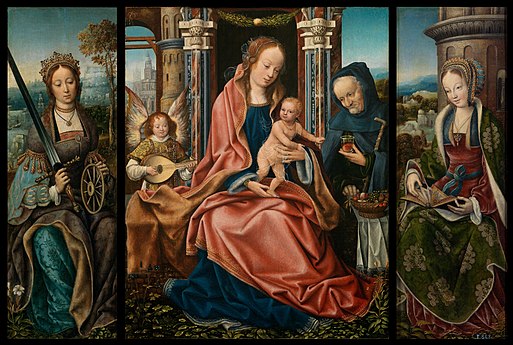Triptych



A triptych (/ˈtrɪptɪk/ TRIP-tik) is a work of art (usually a panel painting) that is divided into three sections, or three carved panels that are hinged together and can be folded shut or displayed open. It is therefore a type of polyptych, the term for all multi-panel works. The middle panel is typically the largest and it is flanked by two smaller related works, although there are triptychs of equal-sized panels. The form can also be used for pendant jewelry.
Beyond its association with art, the term is sometimes used more generally to connote anything with three parts, particularly if integrated into a single unit.[1]
Etymology
The word triptych was formed in English by compounding the prefix
In art
The triptych form appears in early Christian art, and was a popular standard format for altar paintings from the Middle Ages onwards. Its geographical range was from the eastern
From the
The triptych form's transportability was exploited during World War Two when a private citizens' committee in the United States commissioned painters and sculptors to create portable three-panel hinged altarpieces for use by Christian and Jewish U.S. troops for religious services.
The triptych format has been used in non-Christian faiths, including,
Although strongly identified as a religious altarpiece form, triptychs outside that context have been created, some of the best-known examples being works by Max Beckmann and Francis Bacon. When Bacon's 1969 triptych, Three Studies of Lucian Freud, was sold in 2013 for $142.4 million,[9] it was the highest price ever paid for an artwork at auction at that time.[10] That record was broken in May 2015 by $179.4 million for Pablo Picasso's 1955 painting Les Femmes d’Alger.[11]
In photography

A photographic triptych is a common style used in modern commercial artwork. The photographs are usually arranged with a plain border between them. The work may consist of separate images that are variants on a theme, or may be one larger image split into three.[12][13][14]
Examples
- Stefaneschi Triptych by Giotto, c. 1330
- Annunciation with St. Margaret and St. Ansanus by Simone Martini, 1333
- The Mérode Altarpiece by Robert Campin, late 1420's
- The Garden of Earthly Delights, Triptych of the Temptation of St. Anthony and The Haywain Triptych by Hieronymus Bosch
- The Portinari Altarpiece by Hugo van der Goes, c. 1475
- The Buhl Altarpiece, c. 1495
- The Raising of the Cross by Peter Paul Rubens, 1610 or 1611
- The Aino Myth triptych by Akseli Gallen-Kallela, 1891
- The Pioneer by Frederick McCubbin, 1904
- Departure by Max Beckmann, 1932–33
- Three Studies for Figures at the Base of a Crucifixion by Francis Bacon, 1944
Gallery
-
Master of Frankfurt, Sagrada Familia con ángel músico, Santa Catalina de Alejandría, Santa Bárbara, 1510–1520, Museo del Prado, Madrid
-
The Verdun Altar in Klosterneuburg Monastery
See also
- Diptych – Two-part polyptych
- Polyptych – Painting divided into multiple panels
- Polyvision – Widescreen film format
- Three hares – Motif of three hares in threefold rotational symmetry
References
- Merriam-Webster Dictionary. Retrieved January 28, 2017.
Although triptych originally described a specific type of Roman writing tablet that had three hinged sections, it is not surprising that the idea was generalized first to a type of painting, and then to anything composed of three parts.
- doi:10.1093/OED/2659890662. (Subscription or participating institution membershiprequired.)
- doi:10.1093/OED/1119971632. (Subscription or participating institution membershiprequired.)
- D.K. Publishing.
- ISBN 978-0-9910263-0-2.
- S2CID 195041325.
- ISBN 9789953369570. Retrieved January 28, 2017.
- ISBN 978-1577314677.
- ^ "2013 Live Auction 2791 Post-War and Contemporary Evening Sale". Christies.com. Christie's. November 11, 2013. Retrieved 15 March 2022.
- ^ Vogel, Carol (November 12, 2013). "Bacon's Study of Freud Sells for $142.4 Million". The New York Times. Retrieved November 12, 2013.
- ^ A History Of Insane Art Prices Archived 2016-12-28 at the Wayback Machine Digg.com Retrieved 16 November 2015.
- ^ Photo Answers Magazine Archived 2014-11-29 at the Wayback Machine 9 April 2009, Michael Topham
- ^ Digital Photography School: Diptychs & Triptychs – 5 Prime Examples Elizabeth Halford
- ^ Kay, Nate (3 January 2017), Triptych Photography Examples and Ideas, The Photo Argus, retrieved 28 June 2017
- ^ Marcin Latka. "Triptych with Legend of Saint Stanislaus from Pławno". artinpl. Retrieved 3 August 2019.

![Wooden model to the silver triptych of Saint Stanislaus, ca. 1512, National Museum in Warsaw[15]](http://upload.wikimedia.org/wikipedia/commons/thumb/a/a1/Cracow_Legend_of_Saint_Stanislaus_01.jpg/419px-Cracow_Legend_of_Saint_Stanislaus_01.jpg)

